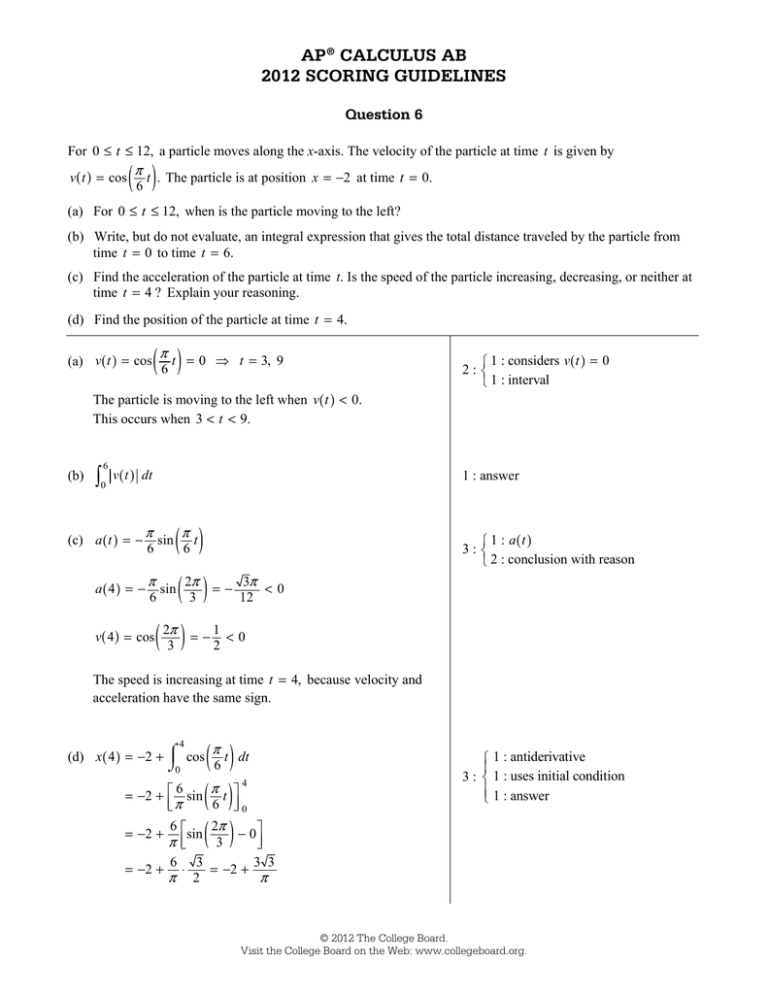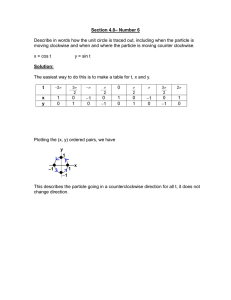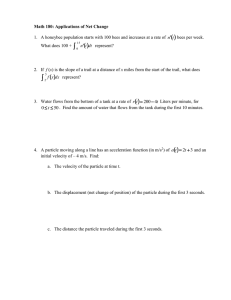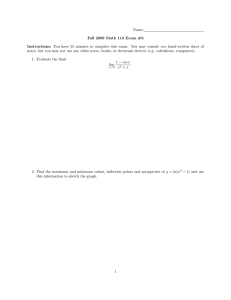AP CALCULUS AB - AP Central
advertisement

AP® CALCULUS AB 2012 SCORING GUIDELINES Question 6 For 0 ≤ t ≤ 12, a particle moves along the x-axis. The velocity of the particle at time t is given by π v( t ) = cos t . The particle is at position x = −2 at time t = 0. 6 ( ) (a) For 0 ≤ t ≤ 12, when is the particle moving to the left? (b) Write, but do not evaluate, an integral expression that gives the total distance traveled by the particle from time t = 0 to time t = 6. (c) Find the acceleration of the particle at time t. Is the speed of the particle increasing, decreasing, or neither at time t = 4 ? Explain your reasoning. (d) Find the position of the particle at time t = 4. (a) v( t ) = cos ( π6 t ) = 0 t = 3, 9 1 : considers v( t ) = 0 2: 1 : interval The particle is moving to the left when v( t ) < 0. This occurs when 3 < t < 9. (b) 6 0 v( t ) dt (c) a ( t ) = − 1 : answer (6 ) π sin π t a( 4 ) = − 6 (3) 1 : a( t ) 3: 2 : conclusion with reason π sin 2π = − 3π < 0 6 v( 4 ) = cos 12 ( 23π ) = − 12 < 0 The speed is increasing at time t = 4, because velocity and acceleration have the same sign. ( π6 t ) dt π 6 = −2 + sin ( t ) 6 π 6 2π = −2 + sin ( ) − 0 π 3 4 cos (d) x( 4 ) = −2 + 0 4 0 = −2 + 6 π ⋅ 1 : antiderivative 3 : 1 : uses initial condition 1 : answer 3 3 3 = −2 + 2 π © 2012 The College Board. Visit the College Board on the Web: www.collegeboard.org. © 2012 The College Board. Visit the College Board on the Web: www.collegeboard.org. © 2012 The College Board. Visit the College Board on the Web: www.collegeboard.org. © 2012 The College Board. Visit the College Board on the Web: www.collegeboard.org. © 2012 The College Board. Visit the College Board on the Web: www.collegeboard.org. © 2012 The College Board. Visit the College Board on the Web: www.collegeboard.org. © 2012 The College Board. Visit the College Board on the Web: www.collegeboard.org. AP® CALCULUS AB 2012 SCORING COMMENTARY Question 6 Overview This problem presented students with a particle in rectilinear motion during the time interval 0 ≤ t ≤ 12. The particle’s position at time t = 0 is given, and the velocity v( t ) is provided. Part (a) asked students to determine the times when the particle is moving to the left, which they should have done by considering the sign of the given velocity function. In part (b) students were asked to provide an integral expression for the total distance traveled by the particle from time t = 0 to time t = 6, which they should have recognized as given by the definite integral of v( t ) over the given time interval. Part (c) asked for the acceleration at time t. Students should have recognized that the acceleration a( t ) is the derivative of the velocity function. Students should have provided a symbolic derivative for the given velocity function, correctly using the chain rule. Students were then asked whether the speed of the particle is increasing, decreasing, or neither at time t = 4. Students should have evaluated both the velocity and the acceleration functions at time t = 4. Because v( 4 ) < 0 and a( 4 ) < 0, the speed of the particle is increasing. Part (d) asked students to find the position of the particle at time t = 4. This is calculated using the expression x( 4 ) = x( 0 ) + 4 0 v( t ) dt. Sample: 6A Score: 9 The student earned all 9 points. Sample: 6B Score: 6 The student earned 6 points: no points in part (a), no points in part (b), 3 points in part (c), and 3 points in part (d). In part (a) the student does not consider v( t ) = 0 and gives an incorrect interval. In part (b) the student subtracts 2 from the correct expression. In parts (c) and (d) the student’s work is correct. Because “the speed of the particle” is included in the question for part (c), the student’s “The particle is increasing” is acceptable. Sample: 6C Score: 3 The student earned 3 points: no points in part (a), 1 point in part (b), 1 point in part (c), and 1 point in part (d). In part (a) the student does not consider v( t ) = 0 and gives an incorrect interval. In part (b) the student’s work is correct. In part (c) the student has a correct expression for acceleration, so the first point was earned. No additional points in part (c) were earned because the student uses an argument based on a( 4 ) with no mention of v( 4 ) . In part (d) the student presents an incorrect antiderivative. The student uses the incorrect antiderivative with the initial condition and earned the second point. The student is not eligible for the answer point. © 2012 The College Board. Visit the College Board on the Web: www.collegeboard.org.






